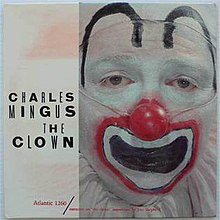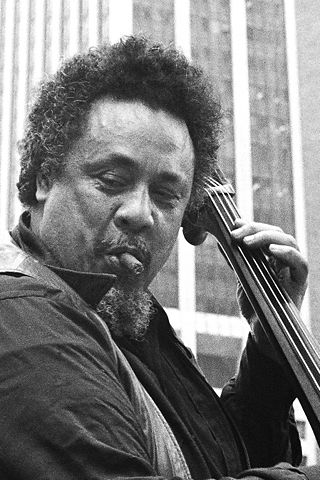
Charles Mingus Jr. was an American jazz upright bassist, composer, bandleader, pianist, and author. A major proponent of collective improvisation, he is considered to be one of the greatest jazz musicians and composers in history, with a career spanning three decades and collaborations with other jazz greats such as Duke Ellington, Charlie Parker, Max Roach, and Eric Dolphy. Mingus's work ranged from advanced bebop and avant-garde jazz with small and midsize ensembles, to pioneering the post-bop style on seminal recordings like Pithecanthropus Erectus (1956) and Mingus Ah Um (1959), and progressive big band experiments such as The Black Saint and the Sinner Lady (1963).

Charles Parker Jr., nicknamed "Bird" or "Yardbird", was an American jazz saxophonist, band leader, and composer. Parker was a highly influential soloist and leading figure in the development of bebop, a form of jazz characterized by fast tempos, virtuosic technique, and advanced harmonies. He was a virtuoso and introduced revolutionary rhythmic and harmonic ideas into jazz, including rapid passing chords, new variants of altered chords, and chord substitutions. Primarily a player of the alto saxophone, Parker's tone ranged from clean and penetrating to sweet and somber.
Jerome Richardson was an American jazz musician and woodwind player. He is cited as playing one of the earliest jazz flute recordings with his work on the 1949 Quincy Jones arranged song "Kingfish".
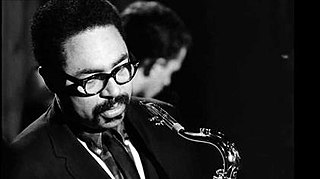
Booker Telleferro Ervin II was an American tenor saxophone player. His tenor playing was characterised by a strong, tough sound and blues/gospel phrasing. He is remembered for his association with bassist Charles Mingus.

Mingus Mingus Mingus Mingus Mingus is a studio album by the American jazz composer and bassist Charles Mingus which was released on January 9, 1964.
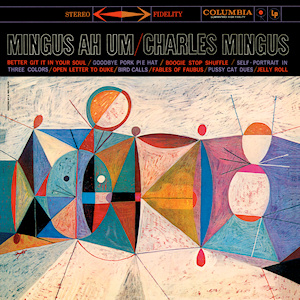
Mingus Ah Um is a studio album by American jazz musician Charles Mingus which was released in October 1959 by Columbia Records. It was his first album recorded for Columbia. The cover features a painting by S. Neil Fujita. The title is a corruption of an imaginary Latin declension. It is common for Latin students to memorize Latin adjectives by first saying the masculine nominative, then the feminine nominative, and finally the neuter nominative singular —implying a transformation of his name, Mingus, Minga, Mingum. The album was inducted into the Grammy Hall of Fame in 2013.

Money Jungle is a studio album by pianist Duke Ellington with double bassist Charles Mingus and drummer Max Roach. It was recorded on September 17, 1962, and released in February 1963 by United Artists Jazz. All but one of the compositions were written by Ellington, with four of the seven on the original LP being recorded for the first time on this album. Later releases on CD added eight tracks from the same recording session.

Charles Daniel Richmond was an American jazz drummer who is best known for his work with Charles Mingus. He also worked with Joe Cocker, Elton John and Mark-Almond.
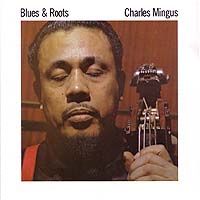
Blues & Roots is an album by Charles Mingus, recorded in 1959 and released on the Atlantic label in 1960. It has been reissued on CD by both Atlantic and Rhino.

Charles Mingus Presents Charles Mingus is an album by the jazz double bassist and composer Charles Mingus, recorded in October 1960 and released in December of the same year. The quartet of Mingus, multi-instrumentalist Eric Dolphy, trumpeter Ted Curson, and drummer Dannie Richmond constituted Mingus' core working band at the time, and had been performing the material on this album for weeks at The Showplace in New York. To recreate this atmosphere, Mingus introduces the songs as if he were speaking to the audience, even admonishing them to not applaud or rattle their glasses. This explains why the recordings on Presents would seemingly give off the illusion of a live album, when in fact it is a studio album.

Charles McPherson is an American jazz alto saxophonist born in Joplin, Missouri, United States, and raised in Detroit, Michigan, who worked intermittently with Charles Mingus from 1960 to 1974, and as a performer leading his own groups.

Kulu Sé Mama is an album by the jazz musician John Coltrane. Recorded during 1965, it was released in January 1967 as Impulse! A-9106, and was the last album released during Coltrane's lifetime.

Mingus Moves is an album by the jazz composer and bassist Charles Mingus, released in 1973.

Night Dreamer is the fourth album by American jazz saxophonist Wayne Shorter. It was released in November 1964 by Blue Note Records. With a quintet of trumpeter Lee Morgan, pianist McCoy Tyner, bassist Reggie Workman and drummer Elvin Jones performing six Shorter originals.

A Modern Jazz Symposium of Music and Poetry is an album by the jazz bassist, composer, and band leader Charles Mingus, released by Bethlehem Records in mid-1959. In spite of the title, the album does not contain any poetry. "Scenes in the City", however, includes narration performed by Mel Stewart and written by actor Lonne Elder with assistance from Langston Hughes. The composition "Duke's Choice" re-appears, in updated form, as "I X Love" on the 1963 album Mingus Mingus Mingus Mingus Mingus. "Nouroog", "Duke's Choice" and "Slippers" form the basis of the suite "Open Letter to Duke" on Mingus Ah Um.

Reincarnation of a Lovebird is a studio album by the American jazz bassist and composer Charles Mingus, recorded in November 1960.

Una Mas, titled Una Mas (One More Time) on the front cover, is a jazz album by trumpeter Kenny Dorham and his quintet, released in 1963 on Blue Note as BLP 4127 and BST 84127. The album would be the next-to-last studio session led by the trumpeter. Una Mas features three compositions by Dorham himself. An outtake from the session, the ballad "If Ever I Would Leave You", comes from the Broadway musical Camelot.

The Essential Billie Holiday: Carnegie Hall Concert Recorded Live is a live album by jazz singer Billie Holiday that was recorded on November 10, 1956 at Carnegie Hall in New York City. The two concerts promoted Billie Holiday's autobiography, Lady Sings the Blues.
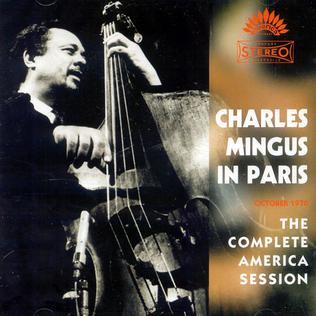
Charles Mingus in Paris: The Complete America Session is a compilation of two albums by American bassist, composer and bandleader Charles Mingus which were recorded in Paris in 1970 and first released on the French America label as Blue Bird and Pithycanthropus Erectus. The compilation was released on the Sunnyside label in 2006 with all the released tracks combined on one CD and a second CD of additional tracks featuring false starts and incomplete takes from the session.

Heroes is a live album by pianist Gil Evans and saxophonist Lee Konitz recorded in New York in 1980 and released on the French Verve label.
